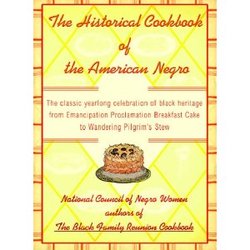On June 18, 1865, a little over two months after the Confederacy surrendered, Union troops arrived in Galveston, Texas, to enforce federal rule. According to tradition, General Gordon Granger, the leader of the Union forces, read the Emancipation Proclamation out loud from the balcony of Union headquarters in the city the next day.
The following year freed slaves celebrated the anniversary of their emancipation on June 19th. The day became known as Juneteenth. It still observed by African Americans throughout the United States. In many communities the festivities begin with a public reading of Emancipation Proclamation followed by music, speeches, prayers, and picnics.
Food, of course, is a big part of the celebration, starting with breakfast. The recipe for this Emancipation Day Breakfast Cake is adapted from a cookbook first published by The National Council of Negro Women in 1935 and reprinted in 2000.
Emancipation Day Breakfast Cake
2 cups flour
3 teaspoons baking powder
1/2 teaspoon salt
1/4 teaspoon cinnamon
1/3 cup sugar
1/3 cup butter
1 large egg
1/2 cup milk
1 to 2 cups fresh blueberries
1/4 cup honey (optional)
Grated rind of one orange (optional)
Grated rind of one lemon (optional)
DIRECTIONS
Set oven to 375°
Grease a 9-inch pie pan
Stir sugar and butter together in a bowl until pale yellow and creamy
Add egg to sugar and butter and continue to beat until mixture is smooth
In a second bowl mix together flour, baking powder, salt, and cinnamon.
Add blueberries and stir gently until they are coated with flour.
Add the sugar/butter/egg mixture.
Add milk.
Mix everything thoroughly. The dough should be somewhat stiff.
Press into the pie pan.
Drizzle with honey and grated orange and lemon rind, if desired.
Score top into wedges with sharp knife.
Cook 20-30 minutes. Insert a toothpick to test. If it comes out clean, cake is done.
Let cool, cut into wedges and eat!
Find out more about Juneteenth and how your community can celebrate.
Photo Credits:
San Jose 2009 Juneteeth Festival
Juneteenth 2010 Berkeley Community Festival
Recipe adapted from The Historical Cookbook of the American Negro by The National Council of Negro Women. First published by the Council in 1935, and republished by Beacon Press in 1992 and 2000.
The following year freed slaves celebrated the anniversary of their emancipation on June 19th. The day became known as Juneteenth. It still observed by African Americans throughout the United States. In many communities the festivities begin with a public reading of Emancipation Proclamation followed by music, speeches, prayers, and picnics.
Food, of course, is a big part of the celebration, starting with breakfast. The recipe for this Emancipation Day Breakfast Cake is adapted from a cookbook first published by The National Council of Negro Women in 1935 and reprinted in 2000.
Emancipation Day Breakfast Cake
2 cups flour
3 teaspoons baking powder
1/2 teaspoon salt
1/4 teaspoon cinnamon
1/3 cup sugar
1/3 cup butter
1 large egg
1/2 cup milk
1 to 2 cups fresh blueberries
1/4 cup honey (optional)
Grated rind of one orange (optional)
Grated rind of one lemon (optional)
DIRECTIONS
Set oven to 375°
Grease a 9-inch pie pan
Stir sugar and butter together in a bowl until pale yellow and creamy
Add egg to sugar and butter and continue to beat until mixture is smooth
In a second bowl mix together flour, baking powder, salt, and cinnamon.
Add blueberries and stir gently until they are coated with flour.
Add the sugar/butter/egg mixture.
Add milk.
Mix everything thoroughly. The dough should be somewhat stiff.
Press into the pie pan.
Drizzle with honey and grated orange and lemon rind, if desired.
Score top into wedges with sharp knife.
Cook 20-30 minutes. Insert a toothpick to test. If it comes out clean, cake is done.
Let cool, cut into wedges and eat!
Find out more about Juneteenth and how your community can celebrate.
Photo Credits:
San Jose 2009 Juneteeth Festival
Juneteenth 2010 Berkeley Community Festival
Recipe adapted from The Historical Cookbook of the American Negro by The National Council of Negro Women. First published by the Council in 1935, and republished by Beacon Press in 1992 and 2000.

Click on the cover to purchase a copy.